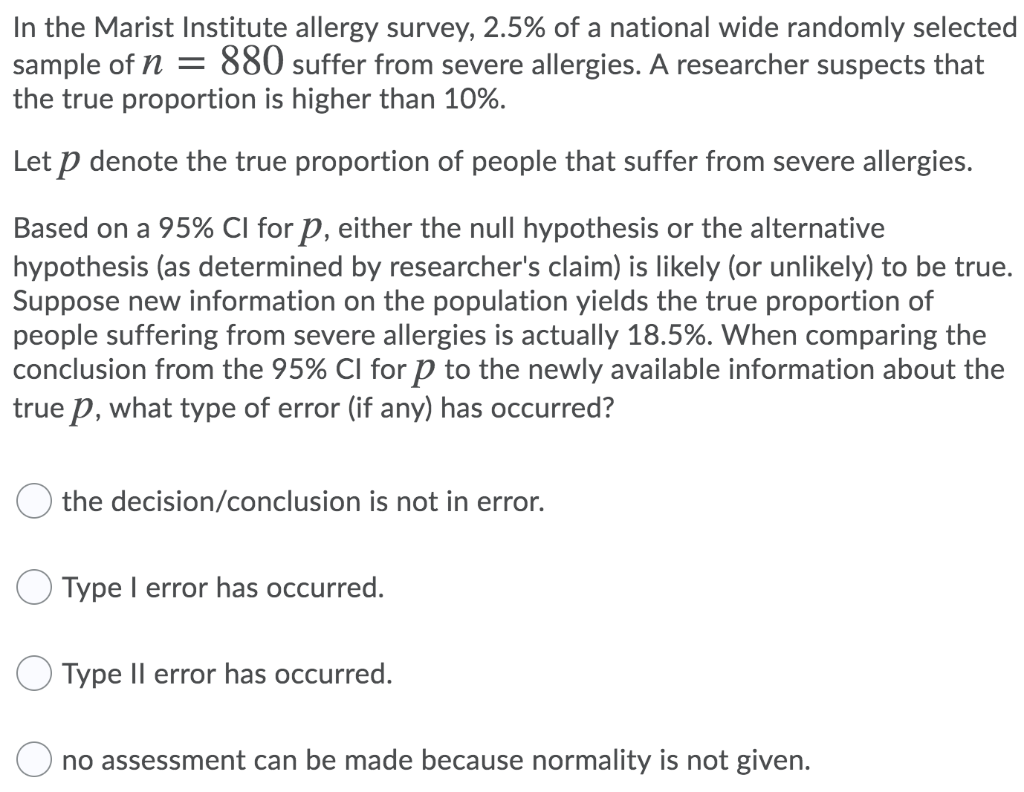In the Marist Institute allergy survey, 2.5% of a national wide randomly selected sample of n = 880 suffer from severe allergies. A researcher suspects that the true proportion is higher than 10%. Let p denote the true proportion of people that suffer from severe allergies. Based on a 95% CI for p, either the null hypothesis or the alternative hypothesis (as determined by researcher's claim) is likely (or unlikely) to be true. Suppose new information on the population yields the true proportion of people suffering from severe allergies is actually 18.5%. When comparing the conclusion from the 95% CI for p to the newly available information about the true p, what type of error (if any) has occurred? the decision/conclusion is not in error. Type I error has occurred. Type II error has occurred. no assessment can be made because normality is not given.
In the Marist Institute allergy survey, 2.5% of a national wide randomly selected sample of n = 880 suffer from severe allergies. A researcher suspects that the true proportion is higher than 10%. Let p denote the true proportion of people that suffer from severe allergies. Based on a 95% CI for p, either the null hypothesis or the alternative hypothesis (as determined by researcher's claim) is likely (or unlikely) to be true. Suppose new information on the population yields the true proportion of people suffering from severe allergies is actually 18.5%. When comparing the conclusion from the 95% CI for p to the newly available information about the true p, what type of error (if any) has occurred? the decision/conclusion is not in error. Type I error has occurred. Type II error has occurred. no assessment can be made because normality is not given.
Holt Mcdougal Larson Pre-algebra: Student Edition 2012
1st Edition
ISBN:9780547587776
Author:HOLT MCDOUGAL
Publisher:HOLT MCDOUGAL
Chapter11: Data Analysis And Probability
Section: Chapter Questions
Problem 8CR
Related questions
Question

Transcribed Image Text:In the Marist Institute allergy survey, 2.5% of a national wide randomly selected
sample of n = 880 suffer from severe allergies. A researcher suspects that
the true proportion is higher than 10%.
Let p denote the true proportion of people that suffer from severe allergies.
Based on a 95% CI for P, either the null hypothesis or the alternative
hypothesis (as determined by researcher's claim) is likely (or unlikely) to be true.
Suppose new information on the population yields the true proportion of
people suffering from severe allergies is actually 18.5%. When comparing the
conclusion from the 95% CI for p to the newly available information about the
true p, what type of error (if any) has occurred?
the decision/conclusion is not in error.
Type I error has occurred.
Type II error has occurred.
no assessment can be made because normality is not given.
Expert Solution
This question has been solved!
Explore an expertly crafted, step-by-step solution for a thorough understanding of key concepts.
Step by step
Solved in 3 steps with 4 images

Recommended textbooks for you

Holt Mcdougal Larson Pre-algebra: Student Edition…
Algebra
ISBN:
9780547587776
Author:
HOLT MCDOUGAL
Publisher:
HOLT MCDOUGAL

College Algebra
Algebra
ISBN:
9781305115545
Author:
James Stewart, Lothar Redlin, Saleem Watson
Publisher:
Cengage Learning

Holt Mcdougal Larson Pre-algebra: Student Edition…
Algebra
ISBN:
9780547587776
Author:
HOLT MCDOUGAL
Publisher:
HOLT MCDOUGAL

College Algebra
Algebra
ISBN:
9781305115545
Author:
James Stewart, Lothar Redlin, Saleem Watson
Publisher:
Cengage Learning